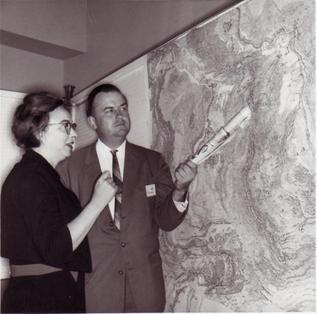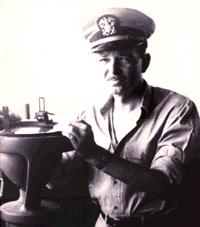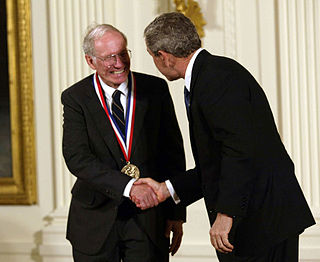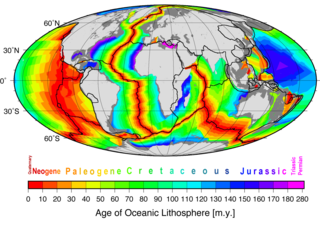Related Research Articles

Bruce Charles Heezen was an American geologist. He worked with oceanographic cartographer Marie Tharp at Columbia University to map the Mid-Atlantic Ridge in the 1950s.

William Maurice "Doc" Ewing was an American geophysicist and oceanographer.

Harry Hammond Hess was an American geologist and a United States Navy officer in World War II who is considered one of the "founding fathers" of the unifying theory of plate tectonics. He is best known for his theories on sea floor spreading, specifically work on relationships between island arcs, seafloor gravity anomalies, and serpentinized peridotite, suggesting that the convection of the Earth's mantle was the driving force behind this process.

The American Geophysical Union (AGU) is a 501(c)(3) nonprofit organization of Earth, atmospheric, ocean, hydrologic, space, and planetary scientists and enthusiasts that according to their website includes 130,000 people. AGU's activities are focused on the organization and dissemination of scientific information in the interdisciplinary and international fields within the Earth and space sciences. The geophysical sciences involve four fundamental areas: atmospheric and ocean sciences; solid-Earth sciences; hydrologic sciences; and space sciences. The organization's headquarters is located on Florida Avenue in Washington, D.C.

John Tuzo Wilson was a Canadian geophysicist and geologist who achieved worldwide acclaim for his contributions to the theory of plate tectonics.

William Jason Morgan was an American geophysicist who made seminal contributions to the theory of plate tectonics and geodynamics. He retired as the Knox Taylor Professor emeritus of geology and professor of geosciences at Princeton University. He served as a visiting scholar in the Department of Earth and Planetary Sciences at Harvard University until his death.
Walter Hermann Bucher was a German-American geologist and paleontologist.
The Logan Medal is the highest award of the Geological Association of Canada. Named after Sir William Edmond Logan, noted 19th-century Canadian geologist. It is presented annually to an individual for sustained distinguished achievement in Canadian earth science.

Edward A. "Ted" Irving, was a geologist and scientist with the Geological Survey of Canada. His studies of paleomagnetism provided the first physical evidence of the theory of continental drift. His efforts contributed to our understanding of how mountain ranges, climate, and life have changed over the past millions of years.
The William Bowie Medal is awarded annually by the American Geophysical Union for "outstanding contributions to fundamental geophysics and for unselfish cooperation in research". The award is the highest honor given by the AGU and is named in honor of William Bowie, one of the co-founders of the Union.
The evolution of tectonophysics is closely linked to the history of the continental drift and plate tectonics hypotheses. The continental drift/ Airy-Heiskanen isostasy hypothesis had many flaws and scarce data. The fixist/ Pratt-Hayford isostasy, the contracting Earth and the expanding Earth concepts had many flaws as well.
Susan L. Beck is a geophysicist and professor of geosciences at the University of Arizona specializing in seismology and tectonics of the American Cordillera.

Alexander J. Dessler was an American space scientist known for conceiving the term heliosphere and for founding the first Space Science Department in the United States.
Edward Bruce Watson is an American geochemist at Rensselaer Polytechnic Institute in Troy, New York.

Kevin C. A. Burke was a geologist known for his contributions in the theory of plate tectonics. In the course of his life, Burke held multiple professorships, most recent of which (1983-2018) was the position of professor of geology and tectonics at the Department of Earth and Atmospheric Science, University of Houston. His studies on plate tectonics, deep mantle processes, sedimentology, erosion, soil formation and other topics extended over several decades and influenced multiple generations of geologists and geophysicists around the world.

Marine geophysics is the scientific discipline that employs methods of geophysics to study the world's ocean basins and continental margins, particularly the solid earth beneath the ocean. It shares objectives with marine geology, which uses sedimentological, paleontological, and geochemical methods. Marine geophysical data analyses led to the theories of seafloor spreading and plate tectonics.
Suzanne Carbotte is a marine geophysicist known for her research on the formation of new oceanic crust.
References
- 1 2 "Walter H. Bucher Medal, Information on the Bucher Medal". AGU.
- ↑ "Walter H. Bucher Medal". American Institute of Physics (AIP) Niels Bohr Library & Archives. (For many years the medal was awarded every two years.)
- ↑ Ackermann, William C. (1968). "First Award of the Walter H. Bucher Medal, April 8, 1968". Transactions, American Geophysical Union. 49 (2): 439. Bibcode:1968TrAGU..49..439A. doi:10.1029/TR049i002p00439.
- ↑ "Walter H. Bucher Medal, Past Recipients". AGU - American Geophysical Union.
- ↑ "Bucher Medal (as of 2011)" (PDF). AGU. 2011.
- ↑ Bradley, W. H. (1969). Walter Hermann Bucher 1888–1965 (PDF). National Academy of Sciences Biographical Memoirs. Washington, D.C.
{{cite book}}: CS1 maint: location missing publisher (link)